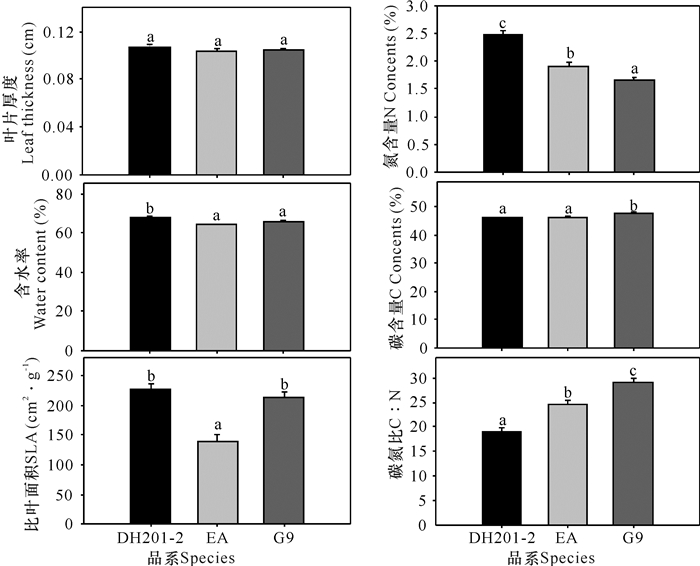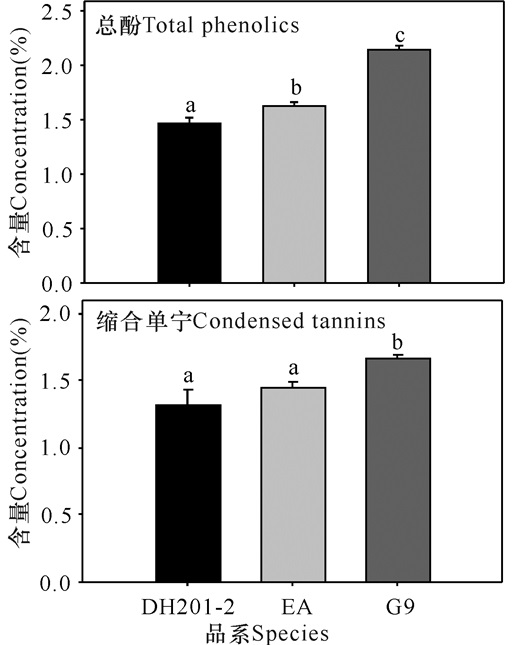2. 广西壮族自治区农业科学院, 广西作物遗传改良与生物技术重点开放实验室, 广西南宁 530007
2. Guangxi Crop Genetic Improvement and Biotechnology Lab, Guangxi Academy of Agricultural Sciences, Nanning, Guangxi, 530007, China
【研究意义】桉树作为一类优良速生丰产用材树种,被世界各地广泛引种栽培[1-2]。目前,桉树已成为我国三大造林树种之一,造林面积仅次于印度,居世界第二[3-4]。广西桉树人工林以每年1.333×105 hm2的速度快速发展,截至2015年,桉树人工林面积稳居全国第一[5]。然而,随着桉树人工林的大面积发展,桉树病虫害也频繁发生,虫害的种类和数量逐年增加,对短周期桉树人工林经营造成了巨大经济损失[6-7]。其中,桉树枝瘿姬小蜂 (Leptocybe invasa) 是原产澳大利亚的一种桉树害虫,目前已对全球几乎所有桉树种植区造成危害[8-9]。筛选高抗优良桉树品系是防治桉树枝瘿姬小蜂的有效途径之一。因此,研究与桉树枝瘿姬小蜂抗性极为相关的理化因子,能为未来筛选抗虫性品种提供理论指导,对桉树资源开发利用具有重要意义。【前人研究进展】不同桉树品系对桉树枝瘿姬小蜂的抗性不同,表现在能否产生虫瘿及虫瘿数量差异上[9-12]。叶片特征、生理生化特性与其对桉树枝瘿姬小蜂抗性具有密切关系[13-15]。王伟等[16]研究发现桉树叶片内单宁含量表现为高抗品系高于高感品系。陈汉章等[13]研究表明桉树抗虫性与叶片含水率呈负相关,而与叶柄含水率呈正相关。张华峰等[9]认为桉树叶柄中多糖含量对桉树枝瘿姬小蜂生长发育影响较大,单宁含量对桉树抗虫性影响较大。吴耀军等[15]研究发现桉树在感染桉树枝瘿姬小蜂前后叶片不同部位缩合单宁含量有显著差异。吕文玲等[17]认为桉树受桉树枝瘿姬小蜂危害后,桉树化学物质组成与含量都有明显变化,且出现了多种新物质,其中以萜品油烯含量最高。Rocha等[18]认为桉树枝瘿姬小蜂能改变寄主植物生理生化代谢响应,从而增强桉树耐寒性。Oates等[19]发现被桉树枝瘿姬小蜂侵染后,抗虫品系与感虫品系在激素、代谢产物等基因表达方面表现出显著差异。【本研究切入点】桉树杂交育种已在全世界范围内广泛应用[20]。桉树杂交种在长势、耐寒性、抗虫性等方面差异很大,从中筛选出优良抗虫无性系具有广阔遗传潜力[20-21]。因此,在全球桉树虫害数量逐年增加的大背景下[7],研究与桉树抗虫性密切相关的理化因子,将能为桉树优良无性系选育提供早期指导[2]。【拟解决的关键问题】通过比较不同桉树品系对桉树枝瘿姬小蜂的抗性及其相关理化性状,并将抗虫性与众多理化性状进行多元回归分析,从而确定与抗虫性紧密关联的关键因子,为今后桉树抗虫品系选育指标的制定提供理论指导。
1 材料与方法 1.1 供试苗木选用窿缘桉Eucalyptus exserta(EA)、巨圆桉Eucalyptus grandis×Eucalyptus tereticornis(DH201-2) 和巨尾桉Eucalpytus grandis×Eucalyptus urophylla(G9) 作为供试苗木。试验在广西大学林学院苗圃内进行。将供试苗木栽入20 cm×15 cm塑料盆中,基质为壤土与草炭土以1:1混合。每种桉树品系各40盆,将其中20盆苗木随机摆放于开放条件下,让其感染虫瘿。剩余20盆用80目网罩罩上,以避免感染虫瘿。每天定时浇水。2个月后调查抗虫性。
1.2 不同桉树品系抗虫性比较在样株树冠中部东、南、西、北4个方位分别剪取一枝长度为35 cm枝条,用自封袋封装,做上标记,迅速带回室内。统计每条枝条上虫瘿数 (包括枝条、叶片、叶脉、叶柄虫瘿),计算样枝平均虫瘿数。根据桉树枝瘿姬小蜂危害情况,依照张华峰[9]的方法制定桉树抗性分级标准,赋予1~4分的抗性得分。
1.3 叶片性状比较从笼罩内未感染虫瘿的植株上采集枝条上第4至第5片叶,将叶片用自封袋封装,迅速带回实验室。用LI-3100C叶面积仪测定叶面积,再用游标卡尺测定叶片厚度。用万分之一天平称取叶片鲜重后,60℃烘干至衡重,称取叶片干重,计算含水率和比叶面积 (Specific leaf area,SLA)。
1.4 化学分析采集完全伸展的第4至第5片叶,50℃烘干后磨成粉,测定植物叶片C、N、总酚、缩合单宁含量,其中,C、N含量 (%) 由德国ELEMENTAR元素分析仪测定,并计算C/N比;总酚和缩合单宁含量采用Folin-Ciocalteu法[22]测定。
1.5 统计分析采用单因素方差分析比较不同品系间抗虫性差异及叶片性状、初生代谢物 (C、N、C/N比) 和次生代谢物 (总酚、缩合单宁) 含量差异。对差异显著的因变量,再采用S-N-K进行多重比较。为进一步分析植物理化性状与抗虫性之间的关系,以植物抗性得分 (Y) 为因变量,总酚 (X1)、缩合单宁 (X2)、C含量 (X3)、N含量 (X4)、C/N比 (X5)、叶片厚度 (X6)、叶片含水率 (X7)、比叶面积 (X8) 等8个因子为自变量,采用逐步回归多元回归分析筛选出与因变量最为相关的自变量,构建回归方程。所有数据统计均采用SPSS18.0进行处理,采用Sigmaplot 13.0进行绘图。
2 结果与分析 2.1 抗虫性比较桉树枝瘿姬小蜂在3个桉树品系上产生的虫瘿数显著不同 (F2, 57=22.818,P < 0.001)。其中,桉树枝瘿姬小蜂只能在DH201-2和EA上产生虫瘿,而不能在G9上产生虫瘿;且DH201-2上样枝平均虫瘿数显著高于EA (图 1)。通过比较3个桉树品系相应的抗性得分可以发现:DH201-2平均抗性得分为1.05±0.22,对桉树枝瘿姬小蜂属于高感;EA平均抗性得分为2.45±0.99,属于低感;而G9由于不能产生虫瘿,所有植株的抗性得分均为4,属于高抗。

|
不同小写字母表示在P < 0.05水平差异显著 Different small letters indicate significant differences at P < 0.05 图 1 桉树品系间样枝平均虫瘿数比较 Fig.1 Comparisons of gall numbers per branch among Eucalyptus species |
3个桉树品系叶片厚度无显著差异 (F2, 57=1.813,P=0.172),但叶片含水率 (F2, 57=9.089,P < 0.001) 及比叶面积 (F2, 57=22.815,P < 0.001) 存在显著差异。其中,DH201-2叶片含水率显著高于EA和G9,但EA与G9叶片含水率无显著差异 (图 2)。EA叶片比叶面积显著低于DH201-2和G9,且DH201-2与G9叶片比叶面积无显著差异 (图 2)。

|
不同小写字母表示在P < 0.05水平差异显著 Different small letters indicate significant differences at P < 0.05 图 2 桉树品系间叶片性状及碳氮含量差异 Fig.2 Differences in leaf traits, N and C contents in leaves among Eucalyptus species |
C含量 (F2, 57=23.161,P < 0.001)、N含量 (F2, 57=41.76,P < 0.001) 及C/N比值 (F2, 57=42.685,P < 0.001) 在品系间存在显著差异。其中,G9叶片C含量显著高于EA和DH201-2,EA与DH201-2叶片C含量则无显著差异。N含量表现为DH201-2 > EA > G9,C/N比则表现为DH201-2 < EA < G9(图 2)。
2.4 叶片总酚和缩合单宁含量比较叶片总酚 (F2, 57=37.965,P < 0.001) 和缩合单宁含量 (F2, 57=5.788,P=0.005) 在品系间表现出显著差异。其中,总酚含量表现为G9 > EA > DH201-2;而G9叶片缩合单宁含量显著高于EA和DH201-2,但EA与DH201-2叶片缩合单宁含量则无显著差异 (图 3)。

|
不同小写字母表示在P < 0.05水平差异显著 Different small letters indicate significant differences at P < 0.05 图 3 桉树品系间叶片总酚和单宁含量差异 Fig.3 Differences in the concentrations of total phenolics and tannins among Eucalyptus species |
逐步回归分析法是按照各变量对因变量作用的显著程度大小来决定是否引入或剔除,可以自动从众多变量中选择重要变量,并建立最优回归方程。通过对8个自变量因子进行逐步回归分析,首先剔除了对抗虫性影响不显著的总酚 (X1)、N含量 (X4)、C/N比 (X5)、叶片厚度 (X6)、叶片含水率 (X7) 及比叶面积 (X8) 等6个自变量,最后进入模型的是缩合单宁 (X2) 和C含量 (X3)。逐步回归分析的步骤见表 1和表 2。
| 表 1 多元回归方程的方差分析 Table 1 Analysis of variance of multiple regression equation |
| 表 2 偏回归系数的显著性检验与标准化偏回归系数 Table 2 Significant test of partial regression coefficients and standardized coefficients |
最终得到抗性得分 (Y) 与缩合单宁 (X2)、碳含量 (X3) 的回归方程:Y=-20.671+2.095X2+0.433X3。经多元回归分析显著性检验和各个标准偏回归系数显著性检验表明,回归常数和所有标准偏回归系数均达到极显著水平 (P < 0.001)(表 1,表 2),说明该方程可以很好地预测桉树抗虫性与2个化学指标间的相关关系。
由表 3可知,2个自变量与抗性得分间的复相关系数R为0.770,校正相关指数为0.578。误差概率P < 0.001,达到了极显著水平,进一步说明缩合单宁与碳含量是影响桉树对桉树枝瘿姬小蜂抗性强弱的主要因子。
| 表 3 桉树2个指标与桉树枝瘿姬小蜂抗性间的复相关分析 Table 3 The multiple-correlation coefficients of two traits of Eucalyptus to resistance against L.invasa |
本研究中,桉树枝瘿姬小蜂不能在G9上产生虫瘿,但能在DH201-2和EA上产生虫瘿,且在DH201-2上的虫瘿数显著高于EA。根据抗性分级标准[12],G9属于抗虫品系,DH201-2和EA属于感虫品系,且DH201-2属于高感,EA属于低感。王伟[16]、张华峰等[11-12]都报道DH201-2是高感品系。诸多文献表明,不同桉树品系对桉树枝瘿姬小蜂的抗性差异很大[9-10, 23],因此,从中筛选出若干高抗优良品系用于大面积推广,是预防桉树枝瘿姬小蜂大面积发生、降低虫害损失的有效措施之一。
植物抗虫性与叶片性状 (如叶片厚度、叶面积、含水率、硬度等) 紧密相关[24]。孙艳丽等[25]报道马尾松针叶长度与其对松突圆蚧的抗性成反比,马尾松针叶容重与其对松突圆蚧的抗性成正比,叶鞘长、叶鞘松紧度与抗虫性不相关。本研究发现3个桉树品系的抗虫性虽然不同,但叶片厚度则无明显差异。陈汉章等[13]研究发现桉树对桉树枝瘿姬小蜂的抗性与叶柄厚度呈正相关。本研究中,DH201-2叶片含水率显著高于EA和G9。张华峰等[12]、陈汉章等[13]也发现,相对于含水率较低的叶片,桉树枝瘿姬小蜂更喜欢在含水率较高的叶柄部位寄生,认为桉树抗虫性与叶片含水率负相关。比叶面积可以反映植物获取资源的能力及植物对不同生境的适应特征[26-27]。本研究发现,EA叶片比叶面积显著低于DH201-2和G9,而DH201-2和G9叶片比叶面积则无显著差异,说明比叶面积并不是决定桉树抗虫性的关键因素。
植物营养物质及次生代谢产物含量直接影响昆虫取食、生长发育和生殖[28]。N含量高的植物组织营养价值较高,更易被昆虫取食。N含量高的锥栗品种具有较高的栗瘿蜂虫害指数[29]。亚洲小车蝗对羊草或针茅的取食能随发育阶段、性别和草的N含量变化进行调整[30]。叶片C含量及C/N比与叶片硬度正相关,而叶片硬度也是植物的一种重要防御指标[31]。本研究中3个桉树品系叶片N含量表现为DH201-2 > EA > G9,G9叶片C含量显著高于EA和DH201-2,C/N比则为DH201-2 < EA < G9。因此,叶片N含量、C含量及其比值能影响桉树抗虫性及桉树枝瘿姬小蜂的生长发育。同时,植物次生代谢物也是植物应对害虫取食危害的一种化学防御手段[32-33]。酚类物质 (包括单宁) 是桉树抵御天敌的重要防御物质,其含量在品系间差别很大[34-35]。本研究中,G9叶片总酚和缩合单宁含量均高于EA和DH201-2,说明酚类物质与桉树对桉树枝瘿姬小蜂的抗性紧密相关,这与王伟[16]、张华峰等[12]的研究结果一致。
植物抗虫策略包括物理抗性和化学抗性,且受诸多环境因子影响,是一个复杂的物理化学过程[36]。虽然已有一些文章研究桉树对桉树枝瘿姬小蜂的抗虫机制[9, 12, 14-15],但大多是定性描述或单一理化指标的简单相关分析,并不能很好地解释导致桉树抗虫性差异的复杂机制。多元回归分析通过剔除与因变量无显著关联或存在共线性的理化因子,筛选出影响因变量的关键因子,已广泛运用到动植物性状与环境因子相关分析及目标性状选育等方面[37-38]。本研究多元回归分析结果表明,缩合单宁和碳含量是影响桉树抗虫性的关键因子,通过这两个指标能较好地反映桉树抗虫性与众多理化指标间的关联性。
4 结论本研究选用3个桉树品系 (DH201-2、EA和G9),比较了品系间对桉树枝瘿姬小蜂的抗性及叶片性状、营养物质和次生代谢物质含量等8个理化指标差异,最后通过逐步多元回归分析了抗虫性与桉树多个理化因子间的关系。结果表明,影响桉树抗虫性的主要因子是缩合单宁和碳含量,且二者均与抗虫性正相关。以上化学指标将能为桉树抗虫性选育指标的确定提供理论依据。目前,桉树枝瘿姬小蜂在全球分布越来越广[9, 39],给桉树产业带来严重威胁[39-40]。因此,在未来我们应加强对桉树抗虫性机制研究,为选育高抗品系及桉树产业可持续发展提供理论支撑。
| [1] |
SIRY J P, CUBBAGE F W, AHMED M R. Sustainable forest management:Global trends and opportunities[J]. Forest Policy and Economics, 2005, 7(4): 551-561. DOI:10.1016/j.forpol.2003.09.003 |
| [2] |
谢耀坚. 中国桉树人工林可持续经营战略初探[J]. 世界林业研究, 2003, 16(5): 59-64. XIE Y J. Primary studies on sustainable management strategy of Eucalyptus plantation in China[J]. World Forestry Research, 2003, 16(5): 59-64. |
| [3] |
温远光. 桉树生态、社会问题与科学发展[M]. 北京: 中国林业出版社, 2008. WEN Y G. Eucalyptus ecology, social problems and scientific development[M]. Beijing: China Forestry Publisher, 2008. |
| [4] |
中国林学会. 桉树科学发展问题调研报告[M]. 北京: 中国林业出版社, 2016. Chinese Forestry Society. Research report on the scientific development of eucalypts[M]. Beijing: China Forestry Publisher, 2016. |
| [5] |
黄国勤, 赵其国. 广西桉树种植的历史、现状、生态问题及应对策略[J]. 生态学报, 2014, 34(18): 5142-5152. HUANG G Q, ZHAO Q G. The history, status quo, ecological problems and countermeasures of Eucalyptus plantations in Guangxi[J]. Acta Ecologica Sinica, 2014, 34(18): 5142-5152. |
| [6] |
PAINE T D, STEINBAUER M J, LAWSON S A. N-ative and exotic pests of Eucalyptus:A worldwide perspective[J]. Annual Reviews of Entomology, 2011, 56: 181-201. DOI:10.1146/annurev-ento-120709-144817 |
| [7] |
项东云, 陈健波, 叶露, 等. 广西桉树人工林发展现状、问题与对策[J]. 广西林业科学, 2006, 35(4): 195-201. XIANG D Y, CHEN J B, YE L, et al. Status, problems and strategies of Eucalyptus plantations developing in Guangxi[J]. Guangxi Forestry Science, 2006, 35(4): 195-201. |
| [8] |
MENDEL Z, PROTASOV A, FISHER N, et al. Taxonomy and biology of Leptocybe invasa gen. & sp.n.(Hymenoptera:Eulophidae), an invasive gall inducer on Eucalyptus[J]. Australian Journal of Entomology, 2004, 43(2): 101-113. DOI:10.1111/aen.2004.43.issue-2 |
| [9] |
张华峰. 桉树枝瘿姬小蜂侵害机理及寄主桉树化学防御研究[D]. 福州: 福建农林大学, 2013. ZHANG H F.Studies on mechanism of Leptocybe invasa infestation and chemical defense of Eucalyptus[D].Fuzhou:Fujian Agriculture and Forestry University, 2013. |
| [10] |
王伟, 徐建民, 李光友, 等. 24个桉树品系遭受桉树枝瘿姬小蜂危害后防御酶活性变化[J]. 中南林业科技大学学报, 2012, 32(6): 24-28. WANG W, XU J M, LI G Y, et al. Defense enzyme activity of 24 Eucalyptus varieties jeopardized by Leptocybe invasa Fisher & La Salle[J]. Journal of Central South University of Forestry & Technology, 2012, 32(6): 24-28. |
| [11] |
张华峰, 陈顺立, 康文通, 等. 桉树枝瘿姬小蜂对不同桉树品系及颜色的选择[J]. 浙江农林大学学报, 2013, 30(6): 904-909. ZHANG H F, CHEN S L, KANG W T, et al. Selection behavior of Leptocybe invasa with different Eucalyptus cultivars and colors[J]. Journal of Zhejiang A & F University, 2013, 30(6): 904-909. DOI:10.11833/j.issn.2095-0756.2013.06.015 |
| [12] |
张华峰, 康文通, 陈顺立, 等. 不同桉树品系与桉树枝瘿姬小蜂危害关系的研究[J]. 福建林学院学报, 2012, 32(4): 345-349. ZHANG H F, KANG W T, CHEN S L, et al. Study on the relationship between Eucalyptus clones and the damage degrees caused by Leptocybe invasa Fisher & La Salle[J]. Journal of Fujian College of Forestry, 2012, 32(4): 345-349. |
| [13] |
陈汉章, 方晓敏, 陈德兰, 等. 桉树叶片特征与桉树枝瘿姬小蜂的抗性关系[J]. 山东农业大学学报:自然科学版, 2015, 46(2): 198-203. CHEN H Z, FANG X M, CHEN D L, et al. The relationship between leaves characteristics of Eucalyptus spp.and the resistance against Leptocybe invasa Fisher & La Salle[J]. Journal of Shandong Agricultural University:Natural Science Edition, 2015, 46(2): 198-203. |
| [14] |
王伟, 徐建民, 李光友, 等. 桉树不同无性系叶片内含物变化与枝瘿姬小蜂抗性的关系[J]. 热带亚热带植物学报, 2012, 20(6): 539-545. WANG W, XU J M, LI G Y, et al. Relationship between inclusion contents in leaves of different Eucalyptus clones and its resistance to Leptocybe invasa[J]. Journal of Tropical and Subtropical Botany, 2012, 20(6): 539-545. |
| [15] |
吴耀军, 常明山, 李德伟, 等. 桉树枝瘿姬小蜂危害对桉树缩合单宁含量的影响[J]. 南京林业大学学报:自然科学版, 2010, 34(6): 1-4. WU Y J, CHANG M S, LI D W, et al. Effect of the damage of Leptocybe invasa Fisher & La Salle on condensed tannin contents of different Eucalyptus clones[J]. Journal of Nanjing Forestry University:Natural Science Edition, 2010, 34(6): 1-4. |
| [16] |
王伟. 桉树对枝瘿姬小蜂抗性及其机制研究[D]. 北京: 中国林业科学研究院, 2012. WANG W.Study on resistance of Eucalyptus to Leptocybe invasa Fisher & La Salle (Hymenoptera:Eulophidae) and its mechanisms[D].Beijing:Chinese Academy of Forestry, 2012. |
| [17] |
吕文玲, 李诺, 杨振德, 等. 桉树枝瘿姬小蜂危害对桉树化学成分的影响[J]. 安徽农业科学, 2012, 40(12): 7137-7139. LV W L, LI N, YANG Z D, et al. Effects of Leptocybe invasa damage on chemical compositions of Eucalyptus[J]. Journal of Anhui Agricultural Science, 2012, 40(12): 7137-7139. DOI:10.3969/j.issn.0517-6611.2012.12.060 |
| [18] |
ROCHA S, BRANCO M, BOAS L V, et al. Gall induction may benefit host plant:A case of a gall wasp and eucalyptus tree[J]. Tree Physiology, 2013, 33(4): 388-397. DOI:10.1093/treephys/tpt009 |
| [19] |
OATES C N, KVLHEIM C, MYBURG A A, et al. The transcriptome and terpene profile of Eucalyptus grandis reveals mechanisms of defense against the insect pest, Leptocybe invasa[J]. Plant and Cell Physiology, 2015, 56(7): 1418-1428. DOI:10.1093/pcp/pcv064 |
| [20] |
POTTS B M, DUNGEY H S. Interspecific hybridiza-tion of Eucalyptus:Key issues for breeders and geneticists[J]. New Forests, 2004, 27(2): 115-138. DOI:10.1023/A:1025021324564 |
| [21] |
BOUVET J M, SAYA A, VIGNERON P. Trends in additive, dominance and environmental effects with age for growth traits in Eucalyptus hybrid populations[J]. Euphytica, 2009, 165(1): 35-54. DOI:10.1007/s10681-008-9746-x |
| [22] |
MAKKAR H P. Quantification of tannins in tree and shrub foliage:A laboratory manual[M]. The Netherlands: Springer, 2003.
|
| [23] |
NYEKO P, MUTITU K E, OTIENO B O, et al. Variations in Leptocybe invasa (Hymenoptera:Eulophidae) population intensity and infestation on Eucalyptus germplasms in Uganda and Kenya[J]. International Journal of Pest Management, 2010, 56(2): 137-144. DOI:10.1080/09670870903248835 |
| [24] |
张风娟, 陈凤新, 徐东生, 等. 植物组织结构与抗虫性的关系 (综述)[J]. 河北科技师范学院学报, 2008, 20(2): 71-76. ZHANG F J, CHEN F X, XU D S, et al. The relationship between plant structure and the insect resistance (Summary)[J]. Journal of Hebei Normal University of Science & Technology, 2008, 20(2): 71-76. |
| [25] |
孙艳丽. 马尾松枝叶特征与其对松突圆蚧抗性的关系[D]. 福州: 福建农林大学, 2010. SONG Y L.The relationship between the characteristic of branch and needle in Pinus massoniana lamb and resistance to Hemiberlesia pitysophila takagi[D].Fuzhou:Fujian Agriculture and Forestry University, 2010. |
| [26] |
李玉霖, 崔建垣, 苏永中. 不同沙丘生境主要植物比叶面积和叶干物质含量的比较[J]. 生态学报, 2005, 25(2): 304-311. LI Y L, CUI J Y, SU Y Z. Specific leaf area and leaf dry matter content of some plants in different dune habitats[J]. Acta Ecologica Sinica, 2005, 25(2): 304-311. DOI:10.17521/cjpe.2005.0039 |
| [27] |
LAMBERS H, POORTER H. Inherent variation in growth rate between higher plants:A search for physiological causes and ecological consequences[J]. Advances in Ecological Research, 2004, 34: 283-362. DOI:10.1016/S0065-2504(03)34004-8 |
| [28] |
彭金英. 植物和昆虫相互关系--植物对植食性昆虫的防御反应和昆虫的生理适应[D]. 上海: 中国科学院研究生院 (上海生命科学研究院), 2005. PENG J Y.Plant-insect interaction-plant defense response against herbivorous insect and the physiological adaptation of insect[D].Shanghai:Shanghai Institutes for Biological Sciences, Chinese Academy of Sciences.2005. |
| [29] |
吴晖. 抗栗瘿蜂锥栗品系的鉴定及抗性机制研究[D]. 福州: 福建农林大学, 2007. WU H.Studies on the resistance characterization and mechanism of resistance of strains of Castanea henryi to Dryocosmus kuriphilus[D].Fuzhou:Fujian Agriculture and Forestry University, 2007. |
| [30] |
张寅至, 葛高飞, 王荣富, 等. 羊草与克氏针茅氮元素含量对亚洲小车蝗取食选择的影响[J]. 安徽农业大学学报, 2014, 41(1): 76-81. ZHANG Y Z, GE G F, WANG R F, et al. Effect of nitrogen content in Leymus chinensis and Stippa capillata on feeding choice of Oedaleus asiaticus[J]. Journal of Anhui Agricultural University, 2014, 41(1): 76-81. |
| [31] |
AGRAWAL A A, FISHBEIN M. Plant defense syndr-omes[J]. Ecology, 2006, 87(sp7): S132-S149. DOI:10.1890/0012-9658(2006)87[132:PDS]2.0.CO;2 |
| [32] |
AKHTAR Y, ISMAN M B. Comparative growth inhibitory and antifeedant effects of plant extracts and pure allelochemicals on four phytophagous insect species[J]. Journal of Applied Entomology, 2004, 128(1): 32-38. DOI:10.1046/j.1439-0418.2003.00806.x |
| [33] |
雒珺瑜, 崔金杰, 王春义, 等. 棉花叶片中棉酚和单宁含量与绿盲蝽抗性的关系[J]. 棉花学报, 2012, 24(3): 279-283. LUO J Y, CUI J J, WANG C Y, et al. Relationship between contents of gossypol acetic acid (GAA) and tannin in cotton leaf and resistance to Apolygus lucorum Meyer-Dür[J]. Cotton Science, 2012, 24(3): 279-283. |
| [34] |
GOODGER J Q D, HESKES A M, WOODROW I E. Contrasting ontogenetic trajectories for phenolic and terpenoid defences in Eucalyptus froggattii[J]. Annals of Botany, 2013, 112(4): 651-659. DOI:10.1093/aob/mct010 |
| [35] |
HAYES R A, PIGGOTT A M, SMITH T E, et al. Corymbia phloem phenolics, tannins and terpenoids:Interactions with a Cerambycid borer[J]. Chemoecology, 2014, 24(3): 95-103. DOI:10.1007/s00049-014-0153-6 |
| [36] |
杨乃博, 伍苏然, 沈林波, 等. 植物抗虫性研究概况[J]. 热带农业科学, 2014, 34(9): 61-68. YANG N B, WU S R, SHEN L B, et al. A review on plant resistance to insect pests[J]. Chinese Journal of Tropical Agriculture, 2014, 34(9): 61-68. |
| [37] |
武路广, 霍梅俊, 刘思奇, 等. 白羊草干草产量与主要农艺性状的多元回归及通径分析[J]. 草地学报, 2013, 21(4): 697-701. WU L G, HUO M J, LIU S Q, et al. Estimating Hay Yield and agronomic traits of Bothriochloa ischaemum (L.) using multivariate linear regression and path analysis[J]. Acta Agrestia Sinica, 2013, 21(4): 697-701. DOI:10.11733/j.issn.1007-0435.2013.04.011 |
| [38] |
安丽, 孟庆磊, 董学飒, 等. 澳洲长鳍鳗各形态性状对体重的影响效果分析[J]. 中国农学通报, 2012, 28(2): 60-64. AN L, MENG Q L, DONG X S, et al. Mathematical analysis of effects of morphometric attributes on body weight for Anguilla reinhardtii[J]. Chinese Agricultural Science Bulletin, 2012, 28(2): 60-64. DOI:10.11924/j.issn.1000-6850.2011-2133 |
| [39] |
常润磊, 周旭东. 桉树枝瘿姬小蜂国外研究现状[J]. 中国森林病虫, 2010, 29(1): 22-25. CHANG R L, ZHOU X D. Research status on Leptocybe invasa Fisher & La Salle in foreign countries[J]. Forest Pest and Disease, 2010, 29(1): 22-25. |
| [40] |
ZHENG X L, LI J, YANG Z D, et al. A review of invasive biology, prevalence and management of Leptocybe invasa Fisher & La Salle (Hymenoptera:Eulophidae:Tetrastichinae)[J]. African Entomology, 2014, 22(1): 68-79. DOI:10.4001/003.022.0133 |
 2017, Vol. 24
2017, Vol. 24 


